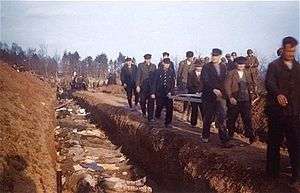Mass grave



A mass grave is a grave containing multiple human corpses, which may or may not be identified prior to burial. Although mass graves can be used during major conflicts, in modern times they are more usually seen after events such as a major famine, epidemic, or natural disaster.
History
Mass graves are a variation on common burial, still occasionally practiced today under normal circumstances. Mass or communal burial was a common practice before the development of a dependable crematory chamber by Ludovico Brunetti in 1873.
In Paris, the practice of mass burial, and in particular, the condition of the Cimetière des Innocents, led Louis XVI to eliminate Parisian cemeteries. The remains were removed and placed in the Paris underground forming the early Catacombs. La Cimetière des Innocents alone had 6,000,000 dead to remove. Burial commenced outside the city limits in what is now Père Lachaise Cemetery.[1]
Mass graves are usually created after a large number of people die or are killed, and there is a desire to bury the corpses quickly for sanitation concerns. In disasters, mass graves are used for infection and disease control. In such cases, there is often a breakdown of the social infrastructure that would enable proper identification and disposal of individual bodies.
The debate surrounding mass graves amongst epidemiologists includes whether or not, in a natural disaster, to leave corpses for traditional individual burials, or to bury corpses in mass graves. For example, if an epidemic occurs during winter, flies are less likely to infest corpses, reducing the risk of outbreaks of dysentery, diarrhea, diphtheria, or tetanus, so the use of mass graves is less important. Recent research indicates that the health risks from dead bodies after natural disasters are relatively limited.[2][3]
The United Nations has defined a criminal mass grave as a burial site containing three or more victims of execution.[4] Mass grave mapping teams have located 125 Khmer Rouge prison facilities and corresponding gravesites to date in Cambodia while researching the Killing Fields. Many mass graves were discovered after the Massacre at Huế during the Vietnam War.
See also
- Afghan Massacre: The Convoy of Death, earlier title: Massacre at Mazar
- Allegations of mass graves at Chemmani
- Chechnya mass graves
- Crab Island (Lake Champlain)
- Duffy's Cut
- Duraiappa stadium mass grave
- Guba mass grave
- Hart Island (New York)
- Maguindanao Massacre
- Mass graves in Iraq
- Mass graves in the Soviet Union
- Mirusuvil mass grave
- Plague pit
- Sooriyakanda mass grave
- Srebrenica massacre
- Trench
- Vukovar massacre
References
- ↑ Krupa, Frederique (1991). "Paris: Urban Sanitation Before the 20th Century".
- ↑ "Mass graves draw out the pain for quake-hit Haitians". Reuters. 20 January 2010. Archived from the original on 24 January 2010.
- ↑ "Infectious Disease Risks From Dead Bodies Following Natural Disasters" (PDF). Pan Am J Public Health. 15 (5). 2004.
- ↑ Human remains and identification. Oxford University Press. 2015. pp. 169–171. ISBN 978-1784991975.
External links
| Wikimedia Commons has media related to Mass graves. |
- Mass Graves of Iraq
- Article about the effects of mass graves after the 2003 Iran earthquake.
- General article about mass graves